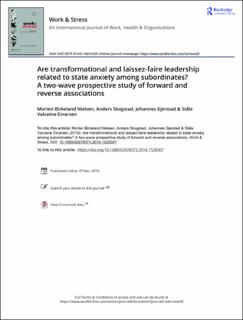| dc.contributor.author | Nielsen, Morten Birkeland | |
| dc.contributor.author | Skogstad, Anders | |
| dc.contributor.author | Gjerstad, Johannes | |
| dc.contributor.author | Einarsen, Ståle | |
| dc.date.accessioned | 2022-04-25T11:09:18Z | |
| dc.date.available | 2022-04-25T11:09:18Z | |
| dc.date.created | 2019-03-08T08:54:11Z | |
| dc.date.issued | 2019 | |
| dc.identifier.citation | Work & Stress. 2019, 33 (2), 137-155. | |
| dc.identifier.issn | 0267-8373 | |
| dc.identifier.uri | https://hdl.handle.net/11250/2992532 | |
| dc.description.abstract | The aim of this study was to determine the direction of associations between perceived leadership styles of an immediate leader and state anxiety among subordinates using time-lagged data from a large and heterogeneous probability sample of Norwegian employees. It was hypothesised that high levels of transformational leadership would be associated with a decrease, whereas high levels of laissez-faire leadership would be associated with an increase, in subsequent levels of anxiety. Reciprocal associations were also expected in that higher levels of anxiety were hypothesised to be related to subsequent increase in reports of laissez-faire, and decrease in reported exposure to transformational leadership. The sample comprised 1149 Norwegian employees. The design was a two-wave full panel study with a six-month time interval between the baseline and follow-up assessments. Contrary to hypotheses, neither transformational nor laissez-faire leadership were significantly related to subsequent levels of state anxiety. In support of hypotheses, baseline low levels of state anxiety were associated with reporting the immediate leader as less transformational and more laissez-faire six months later. In conclusion, the findings challenge theoretical models that explain leadership as a one-way superior–subordinate influence process. | |
| dc.language.iso | eng | |
| dc.title | Are transformational and laissez-faire leadership related to state anxiety among subordinates? A two-wave prospective study of forward and reverse associations | |
| dc.type | Peer reviewed | |
| dc.type | Journal article | |
| dc.source.pagenumber | 137-155 | |
| dc.source.volume | 33 | |
| dc.source.journal | Work & Stress | |
| dc.source.issue | 2 | |
| dc.identifier.doi | 10.1080/02678373.2018.1528307 | |
| dc.identifier.cristin | 1683132 | |
| dc.relation.project | Norges forskningsråd: 250127 | |
| cristin.unitcode | 7476,0,0,0 | |
| cristin.unitname | Statens arbeidsmiljøinstitutt | |
| cristin.ispublished | true | |
| cristin.qualitycode | 2 | |
